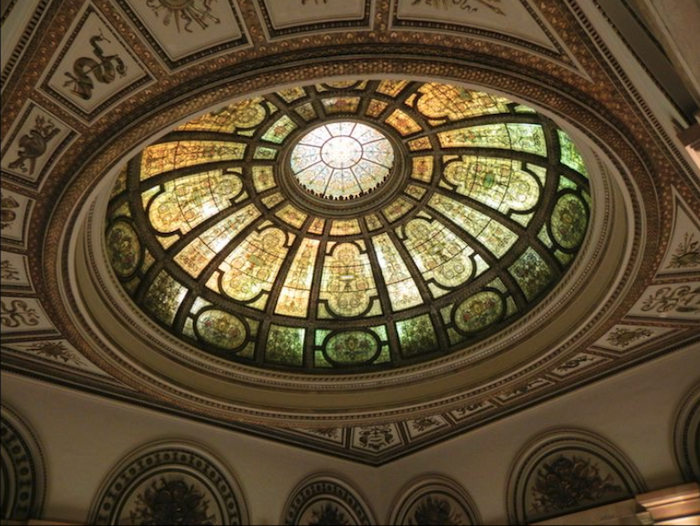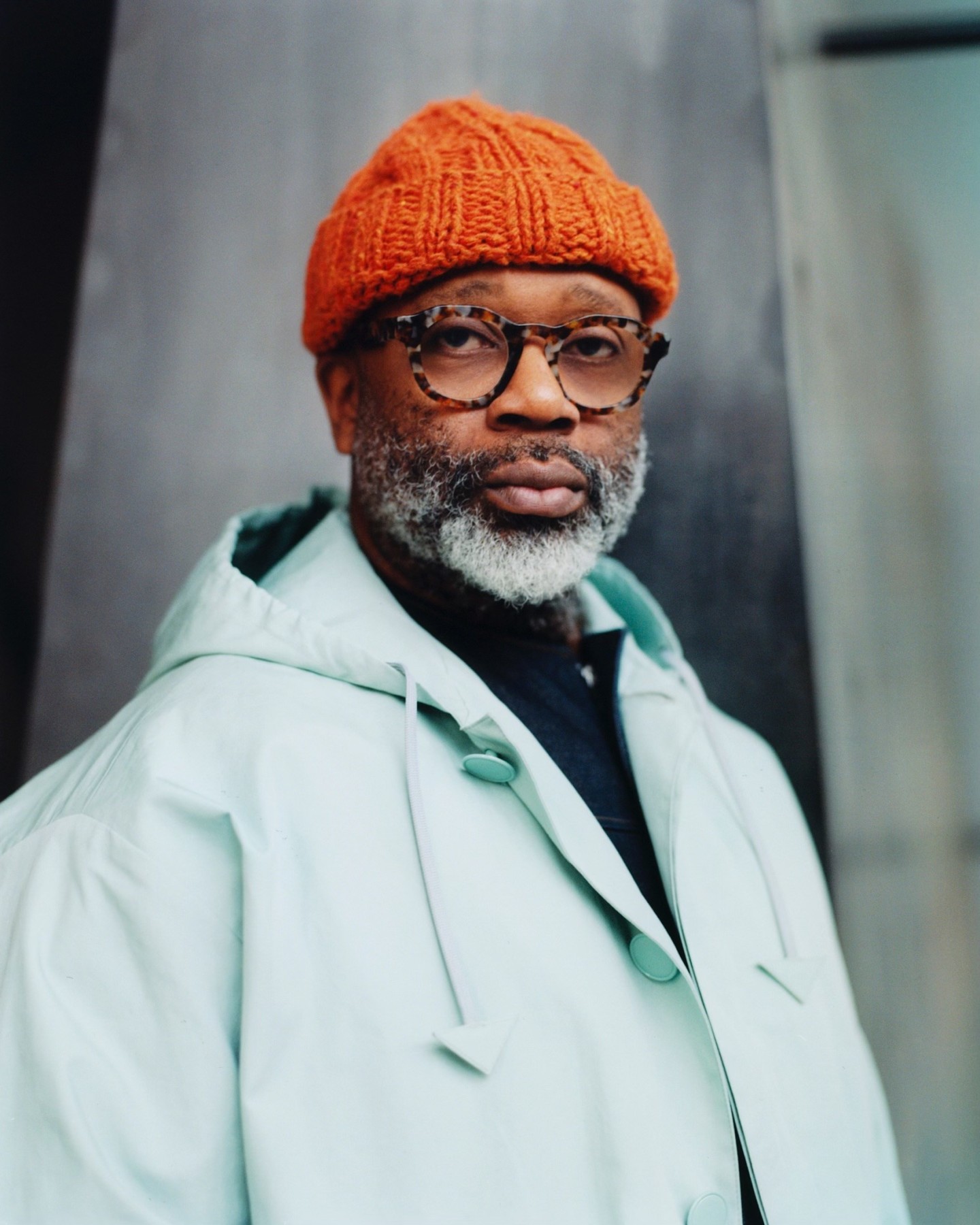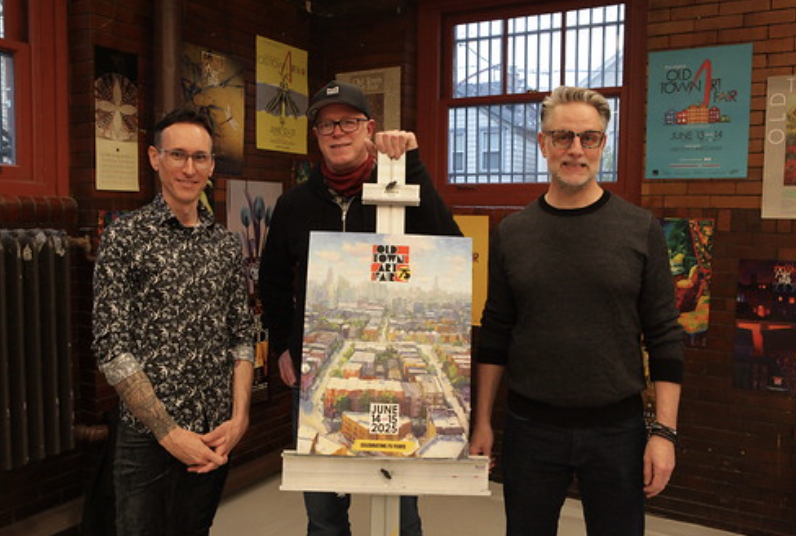City to Begin 12-Month Restoration of the Chicago Cultural Center


Via PR
CHICAGO, IL — Mayor Lori E. Lightfoot and the Department of Cultural Affairs and Special Events (DCASE) today announced the historic restoration of the landmark Chicago Cultural Center to reclaim two lost interiors decorated by the celebrated Tiffany Glass and Decorating Company: the Grand Army of the Republic (G.A.R) Memorial Hall and Rotunda. The museum-quality restoration of the art glass dome and decorative finishes is made possible by a generous grant of services valued at $15,425,000 to the City of Chicago. (The Chicago Cultural Center is home to two magnificent stained-glass domes; the restoration of the Tiffany dome in Preston Bradley Hall was completed in 2008.) The celebrated “People’s Palace” will reopen to the public on June 2, 2021, after closing its doors last March — with new health and safety protocols to be announced soon, new art exhibitions and new visitor amenities. Restoration work will continue until early 2022.
“Throughout the pandemic, our residents and partners in the public and private sector have remained generous supporters of our cultural institutions,” said Mayor Lightfoot. “Thanks to their support and this incredible grant, we will be able to restore and revitalize our landmark Cultural Center — which remains critical to our tourism and recovery efforts and our ability to bring our creative community together.”
The grant (the largest private donation given to DCASE) provides access to a highly specialized team that are uniquely qualified to undertake the restoration. An intricate process will expose the original 1890s surfaces by methodically separating layers of paint. The project also includes the conservation of a 40-foot diameter, 62,000-piece, art glass dome that will return natural light that has been blocked since a renovation in the 1930s. Long-lost lighting fixtures that were custom designed for the rooms will be recreated using early photographs and original architectural drawings.
“With its sparkling mosaics and hovering art glass dome, the Chicago Cultural Center's Preston Bradley Hall has been a must-see attraction for decades. But it’s about to get some stiff competition when restoration of the G.A.R. rooms is completed next year,” said Tim Samuelson, Cultural Historian Emeritus for the City of Chicago.“This project reminds me of hunting for buried treasure. Instead of being buried under the ground, it’s a treasure of Tiffany coloration buried beneath layers of paint — and just waiting to be revealed in all its 1890s glory. This is no ordinary preservation project. It’s an undertaking beyond belief, assembling the absolute top talents in historic restoration to revive one of the great lost treasures of decorative arts.”
When completed next year, the rooms will reflect their historic appearance, but also more ably facilitate a wider range of free and diverse cultural programming. This includes upgraded lighting, electrical, Wi-Fi and more as well as opportunities for artists and organizations to activate the space through a variety of performances and exhibitions.
This project is part of Culture in My Neighborhood, a new collaborative initiative that supports cultural programming at the Chicago Cultural Center, 18 Chicago Park District neighborhood cultural centers, and the Chicago Public Library regional libraries — through grants and commission opportunities for artists and organizations. It seeks to expand access and participation in South and West Side neighborhoods that have lacked traditional cultural infrastructure such as museums and theaters. This program complements an over $40 million capital investment that will break ground in 2021 in the City’s network of cultural centers to upgrade theater, music, dance, and visual art presentation capabilities at these facilities. Artists and organizations will receive financial support — including those who were displaced by the COVID-19 pandemic — and community residents will enjoy free and affordable, high-quality cultural experiences in their own neighborhoods. Culture in My Neighborhood is part of Arts 77, a citywide arts recovery and reopening plan for all of Chicago’s 77 community areas.
“I am thrilled to see the magnificent restoration of the G.A.R. rooms come to fruition. The work will not only improve the building and physical structures, it will enhance the public programming in the building,” said Mark Kelly, DCASE Commissioner. “With this restoration, we also herald a new mission for the Chicago Cultural Center as we link our efforts with the 18 Chicago Park District neighborhood cultural centers and the Chicago Public Library’s regional libraries. We no longer stand alone, but instead are part of a citywide cultural center ecosystem, bringing cultural vitality to all of our citizens.”
The Chicago Cultural Center will reopen to the public on June 2, 2021, with the exhibitions “Jeremiah Hulsebos-Spofford: League of Nations” and “what flies but never lands.” Soon after, “Chicago: Where Comics Came to Life, 1880–1960” will open on June 19. Visitors will also be greeted with new visitor amenities including a reimagined Welcome Center and Learning Lab — and Buddy, a new shop created with the Public Media Institute (online for now at hi-buddy.org) to give Chicago's artists and small manufacturers a place to showcase and sell their goods and artwork. Visit chicagoculturalcenter.org closer to the reopening for updated visitor information including reduced schedule.
The Chicago Cultural Center restoration, which began in February following an intensive year-long study, will take approximately 12 months to complete. The G.A.R. rooms will remain closed to the public during this time. The project is being executed by Harboe Architects and a team of highly specialized preservation experts and artisans, in partnership with the Department of Assets, Information and Services (AIS) in consultation with conservators and Tim Samuelson, Cultural Historian Emeritus for the City of Chicago. The Landmarks Commission reviewed and unanimously approved the project and will provide additional oversight.
About the Grand Army of the Republic (G.A.R.) Memorial Hall and G.A.R. Rotunda Dedicated in 1898, the rooms were created as a place of gathering for Union Civil War veterans and their families, and a place of memory honoring those who died. Reliefs in decorative plaster reflect iconography of war through the ages, richly finished in silver leaf shaded with layers of translucent color. The overall design was a collaborative effort of architect Charles A. Coolidge, partner in the Boston-based firm of Shepley, Rutan and Coolidge, and the New York studio of Louis Comfort Tiffany — a respected and influential American master of color and decorative design. Local artisans executed the work under the supervision of Coolidge and Tiffany’s project manager J.A. Holzer, a notable participant being the Chicago art glass and decorating firm of Healy & Millet who fabricated the 62,000 piece art glass dome. Healy & Millet’s other notable work in Chicago included collaborating with architect Louis H. Sullivan in creating the art glass and painted decorations for the Auditorium Theatre and the trading room of the Chicago Stock Exchange — now reconstructed at the Art Institute of Chicago.
The decorated plaster surfaces were created to meld with lower walls of rich natural marbles — a green-tinted Vermont marble in Memorial Hall and gray Tennessee marble in the Rotunda. All marble is to be cleaned and returned to their original polished finish Also restored will be massive richly-grained mahogany doors.
Dark tinted exterior window glass installed during the 1970s will be replaced with protective filtered clear glass, allowing views of the room to be obtained from the outside. When illuminated at night by re-created period lighting fixtures, the G.A.R will be a highly visible attraction seen both from streets and sidewalks, as well as from Millennium Park.
Editor's Picks
Related:






